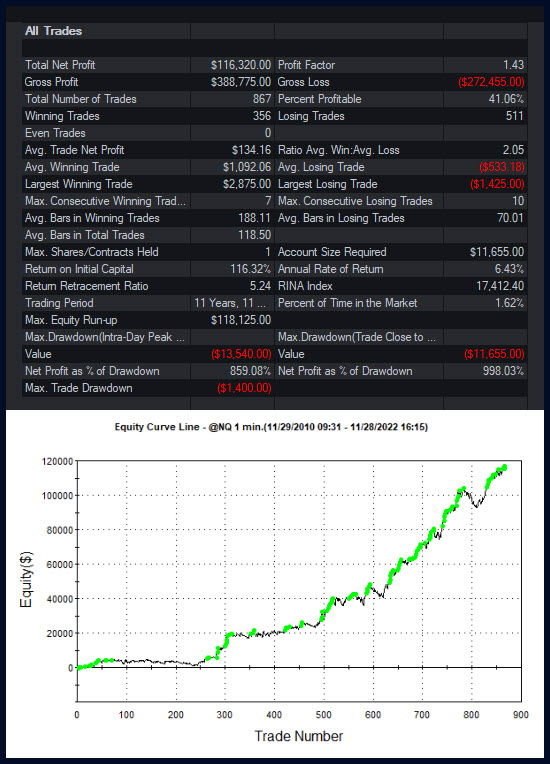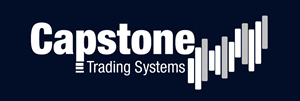Cobra III 2022

The Cobra III 2022 is the updated version of Cobra III, developed to trade one minute bars. We trade this version on the E-mini Nasdaq since the Nasdaq can have very high ranges during high volatility. Accurate backtesting is key and backtesting on lower timeframes is essential for the strategy logic.
The Cobra III 2022 still locks into the pattern that takes advantage of “middle trend” opportunities in the market. The goal is to capture the trend in the middle. It does not trade based on capturing a countertrend or mean reversion move. It also works to capture the move before the market accelerates in a breakout pattern.
This strategy trades on 1 minute charts and uses multiple data series within the algorithm. The CBOE VIX as well as the NYSE Advancers and Decliners are used in the trading rules.
The subscription is a closed code annual subscription and is available in the Tradestation and Multicharts platforms.
Cobra III 2022 1m E-mini Nasdaq is typically included in one of our portfolios.
Cobra III 2022 E-mini Nasdaq
Hypothetical Tradestation Performance Summary
E-mini Nasdaq, One Contract
$25 Round Turn Slippage and Commission
11/29/2010 – 11/29/2022

cntrcts – number of shares/contracts to trade
DontTradeIfHoliday – set to True to not trade on holidays
UseMaxDailyEntries – set to True to limit the number of daily entries.
MaxDailyEntries – 1 is the default. Not in effect unless UseMaxDailyEntries is set to True.
UseMaxDailyLosses – set to True to limit the number of losing trades on a closed bar basis. False by default.
MaxDailyLosses – the number of losing trades allowed per day if UseMaxDailyLosses is True.
DailyLossLimit – set to False by default.
DailyLossLimitAmt – the amount of Daily Loss if DailyLossLimit is True.
WeeklyLossLimit – set to False by default.
WeeklyLossLimitAmt – the amount of Weekly Loss if WeeklyLossLimit is True.
MonthlyLossLimit – set to False by default.
MonthlyLossLimitAmt – the amount of Daily Loss if MonthlyLossLimit is True.
LongStartTime – the time of day that long trades can start signaling.
LongFinishTime – the time of day that long trades stop signaling.
ShortStartTime – the time of day that short trades can start signaling.
ShortFinishTime – the time of day that short trades stop signaling.
LongExTime – the time of day that long trades exit.
ShortExTime – the time of day that short trades exit.
LimitEntPts – the points from the current close where the limit order is placed.
StpLsFirstBar – set to True for a first bar Stop Loss.
StpLsFirstBarAmt – the size of the stop loss on the first bar.
StpLsLong – set to true to make sure the stop loss for long trades are on.
StpLsLongAmt – size of stop loss if StpLsLong is set to True.
StpLsShort – set to true to make sure the stop loss for short trades are on.
StpLsShortAmt – size of stop loss if StpLsShort is set to True.
PrfTgFirstBar – set to True for a first bar profit target.
PrfTgFirstBarAmt – size of profit target on first bar.
PrfTgLong – set to true to turn on the profit target for longs.
PrfTgLongAmt – size of profit target if PrfTgLong is set to True.
PrfTgShort – set to true to turn on the profit target for shorts.
PrfTgShortAmt – size of profit target if PrfTgShort is set to True.
RFStpLsLong – set to True to turn on Range Filter long stop loss
RFStpLsLongMult – the multiplier for the RangeFilter long stop loss
RFStpLsLongMax – the maximum dollar amount for RangeFilter long stop loss
RFStpLsShort – set to True to turn on Range Filter short stop loss
RFStpLsShortMult – the multipler for the RangeFilter short stop loss
RFStpLsShortMax – the maximum dollar amount for RangeFilter short stop loss
RFPrfTgLong – set to True to turn on Range Filter long profit target.
RFPrfTgLongMult – the multiplier for the RangeFilter long profit target.
RFPrfTgLongMax – the maximum dollar amount for RangeFilter long profit target.
RFPrfTgShort – set to True to turn on Range Filter short profit target.
RFPrfTgShortMult – the multiplier for the Range Filter short profit target.
RFPrfTgShortMax – the maximum dollar amount for RangeFilter long profit target.
StpLsLongPct – set to True to turn on Stop Loss long percentage.
StpLsLongPctAmt – the percentage size of stop loss if StpLsLongPct is True.
StpLsShortPct – set to True to turn on Stop Loss short percentage.
StpLsShortPctAmt – the percentage size of stop loss if StpLsShortPct is True.
PrfTgLongPct – set to True to turn on Profit Target long percentage.
PrfTgLongPctAmt – the percentage size of profit target if PrfTgLongPct is True.
PrfTgShortPct – set to True to turn on Profit Target short percentage.
PrfTgShortPctAmt – the percentage size of profit target if PrfTgShortPct is True.
——————-Volatility Filters—————-
UseLimitMoveFilter – Stop trading if there is a limit move at the open if this is set to True.
PercentLimitMove – the size of the limit move as a percentage from the previous day’s close to use if UseLimitMoveFilter is set to True.
UseRangeFilter – turns on a filter for the Range if set to True. Strategy stops trading if average range is too high.
RangFilterL1 – the lookback to measure the average range for the range filter
RangeFilterAmplitude – the multiplier of the average range for the range filter
UseMinimumVIXFilter – set to True to require the VIX to be above MinimumVIX
MinimumVIX – the minimum VIX threshold that the strategy will still trade if UseMinimumVIXFilter is set to True
UseMaximumVIXFilter – set to True to require the VIX to be below MaximumVIX
MaximumVIX – the maximum VIX threshold the strategy will still trade if UseMaximumVIXfilter is set to True.
The time based inputs are based on EST. These inputs will need to be adjusted for the timezone of your computer based on its difference from EST. For example, if your computer is on CST, then LongStartTime should be 845 instead of 945 since CST is one hour earlier than EST.
The stop loss and profit targets are based on a per contract basis. If the cntrcts increases, the dollar amounts for stop loss or profit target do not need to also increase since the stop loss is calculated on a per contract basis.

